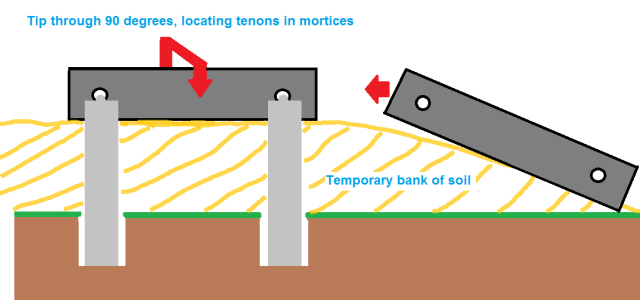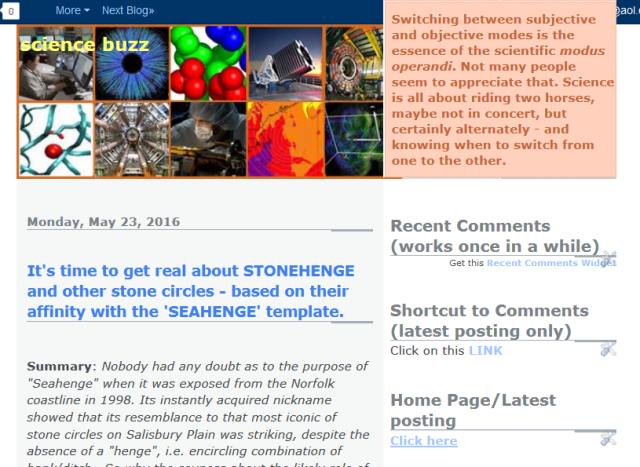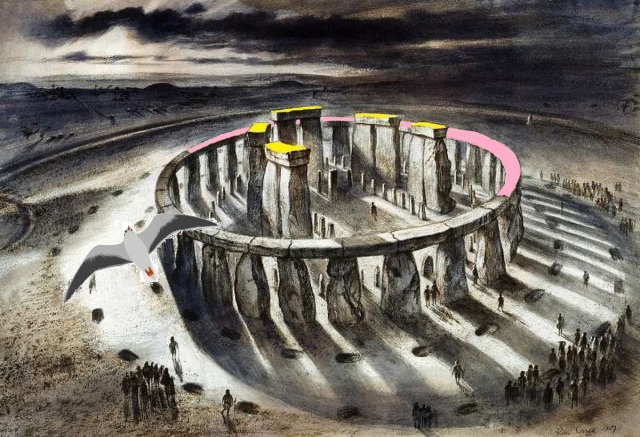WordPress has excelled itself, managing to lose this posting when I hit the Publish key!
Quick repair job: here’s the new image that conveyed this blogger’s latest thinking.

The secret is to slide the lintel up the artificial earth ramp ON ITS SIDE, parking immediately behind the tops of the stone uprights, such that the mortise holes face OUTWARDS, towards the reader. When tenon and mortises are correctly aligned in two dimensions (horizontal and vertical) the lintel is then TIPPED OVER such that tenons slot into the mortices. The arch-like structure is then loosely locked together, sufficently to allow work to proceed safely to completion (remove earth ramp, ram hardcore into gaps beyween uprights and original subsoil).
Afterthought (added 26 Jan 18!)
In fact, the beauty of those mortise and tenon fixtures is that having installed the upright ‘pillars’ in holes that allow for some movement, the next step, i.e. adding the horizontal transom, requires the constructors to locate just ONE of the two joints initially. With that first of two ends secured, it can then be used as a pivot, allowing one to swing the other end round like the hand of a clock until it’s close to the other joint. It’s then just a matter of leverage, end-lifting, proabably aided by temporary support, and final lowering down into place so as to have both ends permanently secured!
(Afterthought: the ramp on the right would probably have been much longer to reduce the steepness of the gradient. It may also have had embedded timber tracks, laid lengthwise or maybe transversely like railway tracks, no doubt greased or wetted with water, to reduce friction. Pulling, via several tow ropes, would have been safer than pushing! Those who audibly questioned the need for a Stonehenge would probably have found themselves assigned to a pushing party.).
It was accompanied by a sizeable amount of text – all of it vanished, possibly for ever, there being no “restore previous draft”key visible.
I’ll try to reconstruct as best I can over the coming days. The caption to my schematic diagram above is new post-apocalyptic text.
As for Google, words fail me….

What does Google think it’s playing at, ignoring and striking out my very first search term, one of just three, in this instance “stonehenge”? Google needs to take a long hard look at itself, and make serious efforts to get back on track, responding first and foremost to the needs of the RESEARCHER.
Despite my increasing annoyance with the antics of the Google search engine, one has to be realistic, and say “If you can’t beat them, join them”. I refer to Google’s own blog hosting platform, namely Blogger Blogspot, which I presently use and have used in the past. By and large that host’s software is a lot simpler, straightforward and less accident/disaster/apocalypse prone than the present site’s. I don’t know who designed the tabs and labels for bloggers on this site: if I did, I’d be tempted to hand them a blank sheet of paper and say “Now start again from scratch, and this time choose words that give some clue as to what this tab or label does when clicked, or which reveals its content when one hovers the pointer …
There’s also the matter of search engine visibility. While Google remains the world’s most popular seacrh engine, one has to be realistic and note that a posting to Google’s Blogger site appears almost instantly in listings under the appropriate search terms, if only “Past Hour”, “Past 24 hours” etc to begin with. Contrast that with WordPress where sometimes it’s 2 or 3 days before the Google web crawler picks up on its presence. (That is not right, incidentally: I do not see why Google cannot make an accommodation with major blog hosters like WordPress to ensure instant indexing of their new postings to ensure a level playing field).
If I see the need for any more postings on Stonehenge/Avebury/Silbury Hill etc, they will be on my sciencebuzz site, this being my last one here.
So what conclusions have I arrived at, after first deliberating on the assorted enigmas for some 4 years (interrupted by a long digression onto the Turin Shroud)?
Here they are in summary form:
- Stonehenge, Avebury and other standing stones served as bird perches, the latter being encouraged to ‘adopt’ the site for the purpose of excarnation of the recently deceased. The primary purpose of excarnation was to (a) release the soul and (b) to isolate the skeleton that was then further cleansed by cremation. The cremated bones were then either buried in situ, OR interred in a nearby round or long burial barrow OR taken back by relatives to the deceased’s home.
- Silbury Hill was a repository for soft organs, probably harvested prior to avian or other excarnation , possibly the heart only. Silbury was what might be called a local speciality provided at the Avebury site/complex, some distance from the Stonehenge/Durrington Walls/Woodhenge/barrow complex some 25 miles away. The soft organs were probably interred with a handful of the deceased’s local turf and soil, probably with a deliberate inclusion of earthworms to ensure complete integration between old and new soil.
- The carpentry aka woodworking joints at Stonehenge were an aid to construction, rather then necessary for final stability (see this post). They served to fix and partly stabilise the intermediary arch-like geometry before removal of the earthern “formwork” i.e. the ramp followed by placement of rammed rubble around the base of each pillar for final anchoring of the structure.
The bluestones were chosen for the Mark 1 Stonehenge because – being smaller than the Mark 2 sarsens, the working surfaces i.e. tops were at eye level and thus visible. They would have quickly become unsightly with uneaten flesh, bird droppings etc. Thus the desirability of importing igneous bluestone in place of local sarsen sandstone. That’s because rocks of igneous origin, i.e. soldified magma and/or lava, (e.g. the predominant dolerites and rhyolites of Preseli and other Welsh ‘bluestones’) are non-porous and liquid -repellent, and thus easier to keep clean and presentable. It may be the lack of local bluestone that prompted the construction of the sarsen megaliths at Stonehenge. Being so much higher, the tops were largely out of human sight, and thus seen as safer more attractive places for scavenger birds (crows, ravens, rooks, seagulls etc) to perch, feed, roost, pass the time of day and maybe even nest.Added note: 26 Jan 2018: the above section is not as clear as it should be, and will be re-written in the next few days.- Automatic numbering that can’t be de-activated is something else that WordPress needs to look at!
- Postscript added May 23, 2016
This blogger’s thoughts on Stonehenge, and indeed 9 other sites with circles of timber or standing stone, have now gelled. Here’s the overall conclusion, inspired by taking another close look at that so-called “Seahenge”on the Norfolk coast.

Posting on my sciencebuzz site, May 23, 2016
Link to the above sciencebuzz posting
…………………………
Addendum: March 16, 2018
Have decided to add the following image as an addendum to ALL my Stonehenge postings (some 24 in all, here and on my sciencebuzz site). Why not – since it’s my considered answer to the ‘mystery’ of the monument’s peculiar architecture, the conclusion to some 6 years of deliberation?
Reminder*

I say Stonehenge was designed as a giant bird perch, a ceremonial monument dedicated to ‘sky burial’, i.e. soul release from mortal remains to the heavens via AFS (avian-facilitated skeletonization, considered the height of fashion (and practicality) in Neolithic-era 2500BC! The stripped remains were then cremated, so an apt description of Stonehenge might, as previously suggested, be PRE-CREMATORIUM.

Latest posting on my sciencebuzz site:
“Was the Mark 1 Stonehenge, initially Chalkhenge, ingeniously designed to attract hungry crows and gulls at the crack of dawn? Why? Pre-crematorium?”
Link:
http://colinb-sciencebuzz.blogspot.co.uk/2016/05/was-mark-1-stonehenge-initially.html
Pingback: Why was Stonehenge constructed with those woodwork joints (mortise and tenon; tongue in groove)? | Sussing out Stonehenge – and Silbury Hill too